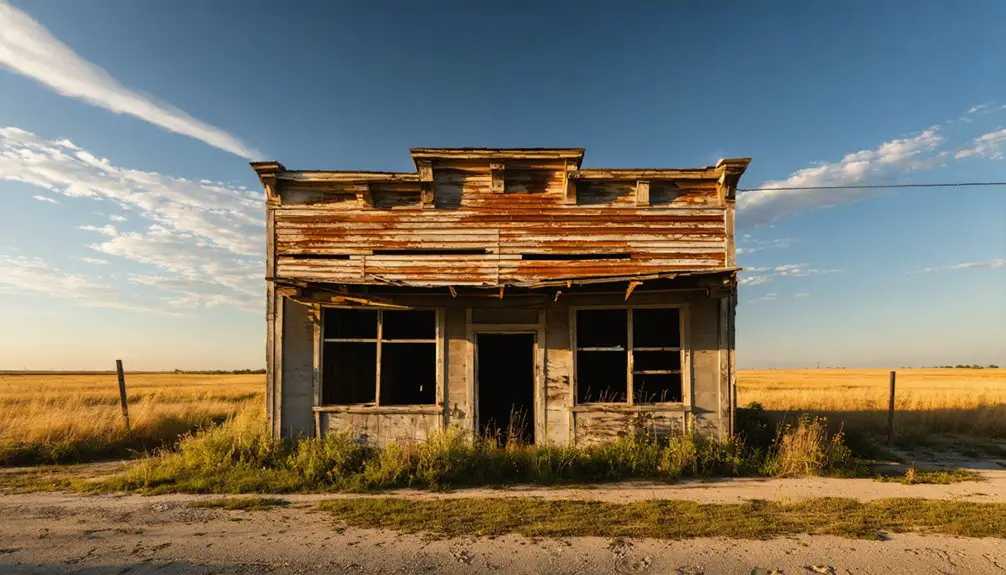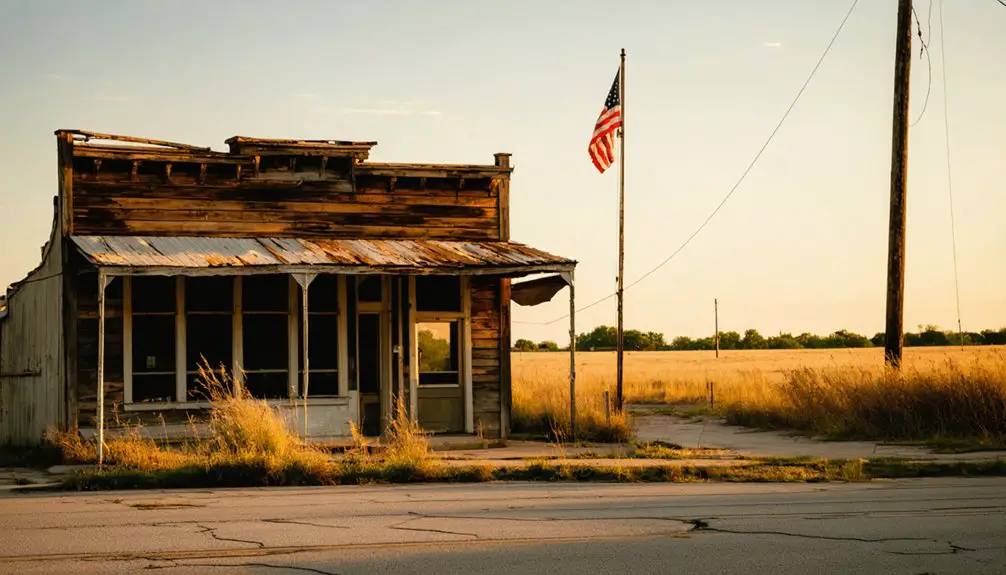You’ll find Francis, Oklahoma’s striking remains along what was once a crucial railroad hub established in 1894. Originally named Newton, this Indian Territory town flourished with over 2,000 residents, featuring a bustling Main Street, First National Bank, and railroad depot. After the 1915 relocation of railroad operations to Ada, Francis’s population plummeted to 400. Today, its weathered storefronts and lone operational post office tell a deeper story of boom-to-bust transformation in early Oklahoma.
Key Takeaways
- Francis, Oklahoma was established in 1894 and experienced rapid growth as a railroad town before declining into a ghost town.
- The town’s population plummeted from over 2,000 to around 400 after railroad turntables were relocated to Ada in 1915.
- Only the post office remains operational among the abandoned storefronts and buildings that line the town’s main street.
- The town’s architectural remnants feature false-front facades and decorative elements that showcase its early 20th-century commercial heritage.
- Local historical societies and volunteer groups work to preserve Francis’s history through documentation and community education efforts.
The Birth of a Territorial Town (1894)
When Oklahoma was still Indian Territory in 1894, the town of Francis emerged as part of the region’s complex transformation from tribal lands to territorial settlements.
Originally named Newton, you’d find this budding community at the crossroads of change, where territorial governance was reshaping the landscape of Indian Territory.
The town’s development reflected the era’s push for agricultural and commercial growth, as settlers sought new opportunities under the expanding federal presence.
Similar to the operations of freight and mail lines that connected settlements from Boggy Depot to Fort Sill, Francis established itself as a vital link in the territory’s growing network of communities.
You’ll recognize familiar patterns in Francis’s layout, designed to accommodate railway access and the surge of homesteaders drawn by the promise of 160-acre parcels.
The First National Bank became a cornerstone of the town’s economic development, symbolizing its growing prosperity and commercial potential.
As U.S. courts and marshals established their authority, the town became a microcosm of the territory’s shifting legal and cultural boundaries, balancing tribal sovereignty with new territorial oversight.
Life in Early Francis: Commerce and Community
As the territorial foundations settled into place, Francis’s early community life took shape around its bustling railroad depot and main commercial street.
You’d find retail establishments like general stores and blacksmith shops serving both locals and travelers along the St. Louis and Oklahoma City Railroad line. A post office, established in 1901, anchored the town’s communication hub, while churches and schools fostered strong social bonds among residents. Like many other territorial liquor towns, Francis thrived by serving alcohol to residents from nearby dry regions. Natural disasters and flooding ultimately contributed to the town’s gradual decline.
Local fairs and community events brought neighbors together, creating lasting connections between farming families and merchants.
Community gatherings and festive fairs wove deep bonds between local farmers and merchants, building a closely-knit territorial society.
You might’ve witnessed teachers, clergy, and shopkeepers forming the backbone of daily life, while farmers sold their produce at town markets.
Simple wooden sidewalks lined the streets where townsfolk gathered, sharing news and conducting business in this modest but vibrant territorial community.
Signs of Change: The Path to Abandonment
When you visit Francis today, you’ll find it hard to imagine the bustling community that once existed before commerce began slipping away in the late 1920s.
The town’s decline accelerated through the 1930s as businesses shuttered one by one, leaving empty storefronts where merchants had once thrived.
Much like nearby abandoned properties in Simran County, the town experienced steady deterioration over time.
Like many other boomtown settlements across Oklahoma that emerged during prosperous resource discoveries, Francis ultimately succumbed to changing economic conditions.
Economic Decline Takes Hold
Despite Francis’s once-thriving lead and zinc mining operations that supported America’s wartime efforts through WWII, the town’s economic foundation began crumbling in the post-war years.
You’d have witnessed the stark reality of resource depletion as ore veins ran dry, triggering a devastating economic downturn that rippled through the community.
The mining industry’s collapse didn’t just affect the workers – it undermined the entire town’s survival.
By the 1960s, international competition forced many local mining operations to close permanently.
As jobs disappeared, you’d have seen businesses shuttering and families moving away.
The dangerous chat pile waste accumulated from decades of mining operations posed serious health risks to those who remained.
The deterioration accelerated when essential services started failing, and infrastructure fell into disrepair.
Without its economic backbone, Francis couldn’t sustain basic amenities, leading to school closures and crumbling roads.
The spiral continued until even the most resilient residents couldn’t justify staying.
Population Exodus Begins
The relocation of significant railroad turntables to Ada in 1915 triggered Francis’s devastating population exodus.
You would’ve witnessed the town’s transformation as its population plummeted from over 2,000 to roughly 400 residents within just a few years, marking an unprecedented 80% decline.
As the railroad’s strategic importance shifted away from Francis, you’d have seen your neighbors packing up and leaving in search of economic opportunities elsewhere.
The mass population migration rippled through the community, forcing local businesses to shutter their doors.
Like many communities during the Trail of Tears, Francis witnessed the forced displacement of Native Americans, adding to the town’s complex history of population changes.
Main Street’s liveliness diminished as essential services disappeared one by one.
While a small group of about 375 residents chose to stay, maintaining a minimal community presence, Francis would never recapture its former railroad-town glory.
Today, the old buildings on Main Street stand as silent witnesses to the town’s once-prosperous past.
Business Closures Accelerate
Following Francis’s population collapse, local businesses faced mounting pressure to survive.
You’d have witnessed the business impact cascade through town as essential services shuttered – first the railroad bypass reduced commerce, then grocery stores and gas stations closed their doors.
The community’s resilience was tested as school consolidations eliminated crucial customer traffic that once sustained local shops and cafes.
What Remains: A Visual Journey Through Time

As you walk down Francis’s once-bustling Main Street, you’ll see weathered storefronts with faded signage and crumbling brick facades that housed thriving businesses in the early 1900s.
The architectural details of these abandoned buildings – from ornate cornices to decorative window frames – reveal the town’s brief period of prosperity during Oklahoma’s oil boom years.
Each empty doorway and broken window tells a story of the community’s gradual decline through the mid-20th century, when residents steadily moved away as economic opportunities dwindled.
Abandoned Main Street Buildings
Standing evidence to Francis’s economic prime, Main Street’s abandoned buildings offer a haunting glimpse into Oklahoma’s early 20th-century architectural heritage.
You’ll find weathered storefronts with boarded windows and faded paint telling stories of a once-bustling community of 2,000 residents. The abandoned storefronts, now silent witnesses to time’s passage, showcase typical commercial vernacular architecture with their false-front facades and wooden frames.
While nature slowly reclaims these structures through creeping vegetation and weather damage, the buildings’ foundations and original architectural elements remain remarkably intact.
Among these quiet sentinels, only the post office continues operations, a lone beacon of activity. These structures, dating back to Francis’s railroad glory days before 1915, stand as reminders of architectural preservation despite years of neglect.
Silent Storefronts Tell Stories
The silent storefronts of Francis beckon visitors into a visual narrative spanning over a century of change. As you walk down Main Street, you’ll find architectural signatures etched in weathered facades, where storefront symbolism reveals the town’s transformation from a bustling railroad hub of 2,000 residents to a quiet community of 400.
Each empty window and fading sign tells a story of community memory, preserving glimpses of daily life before the 1915 railroad turntable relocation changed everything. You can trace the town’s economic shifts through boarded windows and vacant doorways, while the operational post office stands as a symbol of endurance.
These storefronts serve as powerful cultural artifacts, inviting you to piece together Francis’ journey from prosperity to quiet persistence.
Weathered Architectural Details
Time-worn architectural elements throughout Francis reveal layers of the town’s century-long story.
You’ll notice weathered facades where paint peels back to expose multiple generations of color, each layer marking a different era in the community’s history. Decorative cobalt-blue tiles peek through accumulated sand, while concrete bathtubs and stone fireplaces stand as stubborn reminders of domestic life.
Look closely at the architectural remnants, and you’ll see how nature’s relentless forces have shaped what survives.
Staircases lead to phantom second floors, their wooden steps gradually surrendering to rot. Window frames, now empty, frame views of interior walls where wallpaper patterns fade into bare plaster.
These aren’t just decaying structures – they’re chapters of Francis’s evolution, written in wood, brick, and stone.
Francis Among Oklahoma’s Lost Towns

Among Oklahoma’s estimated 2,000 ghost towns, Francis stands as a compelling example of how railroad-driven economies shaped and reshaped communities in the early 1900s.
You’ll find Francis’s historical significance reflected in its dramatic transformation from a bustling railroad town of 2,000 residents to a quiet community of 400 after Ada claimed the crucial turntables in 1915.
Unlike many of Oklahoma’s completely abandoned ghost towns, Francis has maintained a modest but persistent presence.
You can still visit its functioning post office and observe the weathered buildings along Main Street.
While other ghost towns succumbed to resource depletion, natural disasters, or dam construction, Francis’s story primarily revolves around the railroad’s departure – a reflection of how transportation decisions could make or break frontier communities.
Preserving the Legacy of Francis
Preserving Francis’s rich history has become a collaborative mission spanning multiple generations and organizations since the 1960s.
You’ll find local historical societies working tirelessly on cultural preservation through oral history projects, archival documentation, and building restoration efforts.
When you explore Francis today, you’ll see the results of dedicated historical documentation initiatives.
Academic researchers have compiled extensive records, while universities and museums provide expert analysis of the town’s decline.
You can access digital archives of photos, maps, and documents that tell Francis’s story.
Despite challenges like limited funding and structural deterioration, volunteer groups keep the site accessible through regular maintenance.
Through Route 66 tourism, educational programs, and community events, Francis’s legacy continues to educate visitors about Oklahoma’s pioneer heritage.
Frequently Asked Questions
Are There Any Documented Paranormal Activities or Ghost Sightings in Francis?
You won’t find documented ghost stories or local legends from Francis. No paranormal investigations, eyewitness reports, or historical records indicate supernatural activity in this small Oklahoma town’s quiet history.
Can Visitors Legally Explore the Remaining Structures in Francis Today?
You can’t legally explore structures without permission, as exploration regulations require property ownership consent. Most buildings are on private land and you’ll need explicit approval before entering.
What Happened to the Original Residents When They Left Francis?
In a mass exodus around 1915, original inhabitants scattered like leaves in the wind, with most relocating to Ada’s bustling railroad scene or shifting to farming communities across Pontotoc County.
Are There Any Annual Events or Gatherings Still Held in Francis?
You won’t find any community gatherings or local traditions happening in Francis today. As a ghost town, it no longer has the population or infrastructure to support organized annual events.
Does Anyone Still Maintain Family Graves or Cemeteries in Francis?
While you’ll find scattered examples of local families visiting ancestral plots, there’s no documented regular grave maintenance in the area. Like many ghost town cemeteries, upkeep depends on occasional volunteer efforts.
References
- https://en.wikipedia.org/wiki/List_of_ghost_towns_in_Oklahoma
- https://www.youtube.com/watch?v=OF-bpvVR6-I
- https://www.okhistory.org/publications/enc/entry?entry=GH002
- https://newforums.com/our-titles/best-of-the-region/places-routes/ghost-town-tales-of-oklahoma-unforgettable-stories-of-nearly-forgotten-places/
- https://kids.kiddle.co/List_of_ghost_towns_in_Oklahoma
- https://okgenweb.net/~okmurray/Murray/history.htm
- https://gateway.okhistory.org/ark:/67531/metadc2123984/m1/10/
- https://en.wikipedia.org/wiki/Oklahoma_Territory
- http://www.okterritory.org
- https://core.ac.uk/download/215195822.pdf



